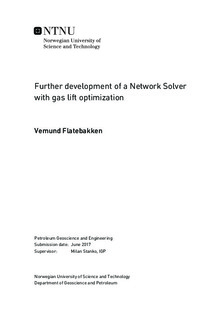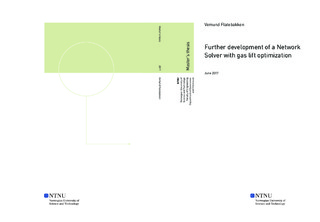| dc.description.abstract | The present Master's Thesis describes a further development of a Network Solver that checks if a certain oil rate is feasible for a given reservoir pressure. Reservoir pressure and surface formation rates are the inputs to the Solver. These inputs may be generated from software (Eclipse or similar) or tables. In the "main.m" script of the Solver all inputs and properties of the fluids (at surface), the reservoir and the network may be specified by the user.
If the production rate cannot be attained with the given input data, the Solver tries to find a gas lift rate that will make the production feasible. If the maximum gas lift rate is exceeded, the formation rate will be lowered until a feasible solution is found. Economics is not part of this Solver yet, thus instead of comparing oil- and gas prices to find the optimal solution, the Solver assumes that "oil is more valuable than gas". Therefore, once the maximum gas lift rate is exceeded, the gas lift rate will be kept at maximum while the Solver is trying to find the highest formation rate possible.
The Network Solver consists of two main parts: A simulator that, based on mathematical correlations, calculates pressure values in the entire network for the given inputs, and an Optimizer that tries to find the best, feasible formation- and lift rates. Only the Network Simulator is further developed in this master thesis project, the Network Optimizer is unchanged.
Four additions have been made to the Network Solver: A mechanistic approach for pressure drop calculations have been included as an alternative to the Beggs and Brill method, heat transfer calculation and temperature drop have been included in the pipes, a Compositional Model has been included as an alternative to the the black oil model, and a simple reservoir Material Balance Model has been added.
The mechanistic pressure drop calculations are shown to be more accurate than the Beggs and Brill method. The calculated pressure and temperature profiles correspond well with commercial software used in industry. The Compositional Model provides accurate calculations of local fluid properties, but the runtime is slow compared to the black oil model. The Material Balance Model is a simple, but useful addition to the software suite. It has its limitations, but works well together with the Network Solver.
The Network Solver developed may be further improved by including an economical aspect, by improving the runtime of the Compositional Model, and by exchanging the Material Balance Model for a more elaborate material balance program. | |

